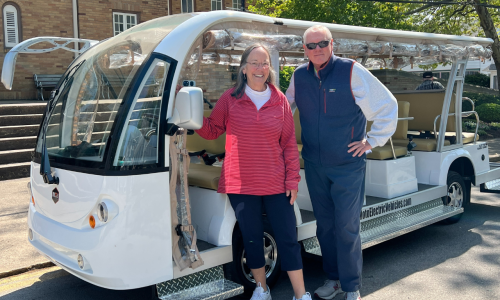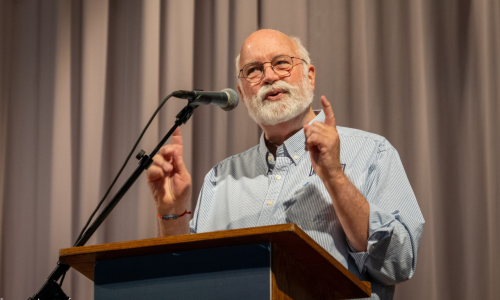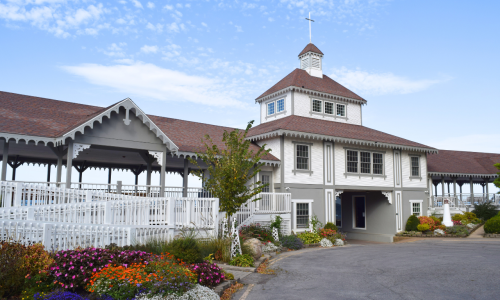A trip to Lakeside leads to Gulfside
By Kevin Greer
Lakeside Communications Manager
One hundred years ago, a new community was started on Mississippi’s Gulf Coast that was based on religion, education, arts and recreation.
Sound familiar?
Gulfside Assembly in Waveland, Mississippi, is celebrating its 100th Anniversary this year, and Lakeside was a key inspiration for the organization’s start.
The first leader
In 1920, Robert Elijah Jones was elected as the first African American bishop in the Methodist Episcopal Church. He was assigned to the Central Jurisdiction, which was formed in 1939 as the only jurisdiction set by race rather than geography, separating administrative duties for African American members. Based in New Orleans, Bishop Jones presided over almost 350,000 congregants in the states of Texas, Louisiana, Mississippi and Alabama.
In 1914, Booker T. Washington had written a letter of reference to E.M. Avery, Vice President of Britt Lyceum and Chautauqua System, for Jones to speak at one of the Chautauqua sites. In 1922, he was invited to speak at the School of Mission at Lakeside. Jones was so impressed with the facility and programs, he decided he wanted a similar facility for the people in the Central Jurisdiction.
A new Chautauqua
Jones raised $4,000 with the help of clergy, individuals and churches, and in 1923 purchased 300 acres on the beach in Waveland, about 50 miles from New Orleans, and leased an additional 300 acres. He envisioned Gulfside as a place where African Americans could congregate and take part in all the Chautauqua pillars.
Gulfside was originally named the Gulfside Chautauqua and Camp Meeting Ground. On Jan. 24, 1924, it was renamed Gulfside Assembly, but the four pillars continued to be the main focus. On the property, there was a 23-bedroom house that was previously owned by descendants of Andrew Jackson. The house was dilapidated and overgrown with weeds. Bishop Jones led the effort to restore it and convert it into the year-round Poor Boys’ School. Most areas in Mississippi did not provide public education for African Americans past the third grade. During the summer, activities included camp meetings, conferences and training for pastors.
The Jackson house mysteriously burned down in 1935 and Bishop Jones was able to raise money to rebuild in its place. Cabins and cinder block structures were built by the boys who lived on the grounds along with local craftsmen. There were educational classes, recreational activities, special events and other activities on the grounds.
In 1944, Bishop Robert Brooks took over the administration of Gulfside. Under his watch, Gulfside added 10 buildings, including the Longmore Inn, which had a full dining room, large lobby and gift shop and could house 100 guests. Harry Hoosier Hall was a 1,000-seat auditorium with an elaborate organ. The venue was used for cultural activities, musical events, college fairs and other events.
Bishop Jones Hall, a two-story administrative building, housed conference rooms, classrooms and offices. Cabins with screened porches were located at the back of the property. Jones had a house toward the back of the property which was used for group retreats. The beach across the road from the community was part of the property and was the only beach along the entire Gulf Coast open to Blacks.
Leontyne Price, the first African American soprano to receive international acclaim, performed at Gulfside during her career. While visiting the Chautauqua as a young child, an adult chastised her and said she shouldn’t be playing the piano. Jones stepped in and allowed Price to continue. His message was that children should be encouraged and nurtured. Price went on to become a renowned opera singer, and her experience at Gulfside played a part in her success.
“Gulfside was a place that nurtured us when we got there,” Gulfside Executive Director Cheryl Thompson said. “African Americans were allowed to self-actualize in terms of if you were good in sports, music or whatever, you had an opportunity to do those things with encouragement and support from the individuals who ran those programs.”
Gulfside’s growth
As word spread across the South, Gulfside became a popular spot. Religious organizations, YMCA, YWCA, Girl Scouts, Boy Scouts and United Methodist Youth Fellowship groups made trips to the community. Colleges, especially Historically Black Colleges and Universities (HBCU) in the South, would visit with their students. The community became a meeting place where Black and white Methodists could come together despite strict racial segregation laws.
In 1955, a pier was built on the beach in front of Gulfside. People would gather there to observe beautiful sunrises and sunsets, sing hymns or go crabbing.
During the 1960s, several Civil Rights leaders visited Gulfside. Jesse Jackson, Bob Moses, Medgar Evers, Julian Bond and Andrew Young were among those who spoke or conducted workshops. The NAACP and other organizations utilized the Chautauqua community to meet and house attendees. The community also hosted Freedom Schools, which were part of a nationwide effort during the Civil Rights Movement to achieve social, political and economic justice. In 1962, Attorney Constance Baker Motley’s headquarters was Gulfside as she waged a legal battle against segregation at the University of Mississippi Law School.
Hurricane headaches
Having property right on the Gulf of Mexico has advantages like beautiful views and beach access. However, the warm waters tend to churn up major hurricanes, and Gulfside has been in the path of three destructive storms.
In 1947, an unnamed Category 4 hurricane struck the Mississippi Gulf Coast, destroying many buildings on Gulfside’s campus. On Aug. 17, 1969, Hurricane Camille hit the Mississippi coast and the damage again was extensive. The trustees, led by Methodist Bishops Mack B. Stokes and Ernest T. Dixon and laymen Wayne Calbert and Henry Harper, fought to preserve the resort in the 1970s and 1980s. They raised money outside the Methodist Church for the first time to rebuild some of the facility’s structures.
After the rebuilding was complete, Gulfside was vibrant again. Family reunions, weddings and other events at Longmore Inn were back. There was an after-school program and daycare during the day. College fairs were a huge attraction, as students from surrounding states registered for college and received scholarship information in the auditorium.
“That was usually a big event,” Thompson said. “They would bus kids in from other parts of Mississippi, as well as Texas, Louisiana and Alabama.”
In August 2004, the dedication of the new Bishop Alfred Norris Hall took place. The raised structure overlooked the gulf and added a conference room and accessible lodging waterfront balconies.
On August 29, just three weeks after this dedication, Gulfside took a direct hit from Hurricane Katrina. All 13 structures on the property were destroyed, including Bishop Alfred Norris Hall and the pier. Debris was all that remained of the beautiful community. Thompson will never forget what she saw when she went back to Gulfside after the storm.
“That immediate shock was unbelievable,” Thompson said. “I could not believe that everything was gone. Waveland was ground zero for Katrina, so Gulfside was wiped off the map.”
Post-Katrina struggles
Waveland was a depressed area before Katrina. Many low-income families went from little to almost nothing after the storm.
“Katrina knocked the wind out of our sails,” Thompson said. “The entire community and the towns around us lost the sense of hope.”
In 2016, an open-air chapel was constructed on the beachfront property named after Bishop Leontine Kelly. It’s used for meetings, church services, health fairs, concerts and community events.
Rebuilding process
Gulfside is working on a long-term strategy to enhance and increase its ministries to better serve as a catalyst for uplifting the community. There are currently 17 board members and countless volunteers who have been integral to this work.
In January 2022, Gulfside was gifted a decommissioned church to use for ministry. They were also assigned a full-time missionary to serve as the Community Outreach Coordinator.
Gulfside conducted an assessment to identify community needs and established two groups of local leaders from faith-based and non-profit organizations which work in tandem to supply volunteers, raise funds, identify critical needs and take action.
Gulfside has implemented a cross-generational community garden with assistance from local Master Gardeners and the County Cooperative Extension. Students from the local Catholic High School built the sheds and raised beds, while members of the Boys and Girls Club and a nearby 4-H Club planted the seeds. Gulfside is also working with the chaplains from the Veterans Affairs (VA), which is providing programs for clergy on dealing with trauma and other topics.
Students from a junior college are assisting Gulfside in planning a Youth Life Skills program to begin this year. The goal is to provide youth with hands-on opportunities to enhance their problem-solving, team building and leadership skills. At the beginning of the school year, Gulfside issued 100 uniform vouchers to local school children in need.
100th Anniversary Celebration
Even though it still has obstacles to overcome, Gulfside has plenty to celebrate during its 100th Anniversary this year. The celebration starts Thursday, April 27 with a “meet and greet,” followed by a golf tournament fundraiser and evening gala the next day. On Saturday, April 29, Gulfside will hold a community service project, providing boxes of food and other household items to nearly 100 families.
An exhibit of Gulfside’s history and current ministries will be on display now until May 6. Thompson and Gulfside missionary Althea Belton plan to speak about the Chautauqua’s history and current ministries at museums, colleges and churches throughout the region. A documentary is also in the works and should be completed in the fall.
Gulfside’s future
Even with a steep uphill climb, Thompson remains hopeful for Gulfside’s future. She said the main goal is to continue the ministry of advocacy and focus on those individuals who are in need. They also want to provide more cultural activities, spiritual uplifting and recreation.
Thompson, a retired nurse executive, was a board member for 20 years before being asked to take on the role as Executive Director. Her late mother made sure she had the “Gulfside experience” and she is serving the organization in her honor.
“I have a love of Gulfside as my mother did before me,” Thompson said. “I keep hearing her voice in my head saying, ‘You need to take care of Gulfside.’ So, I’m trying to do that.”
She plans to visit Lakeside for the Chautauqua Trail gathering in August to talk about Gulfside’s history and share ideas for the future.
“Lakeside is where we got our start,” Thompson said. “If it wasn’t for Lakeside, I don’t know if Bishop Jones would’ve gotten the idea. If there are occasions where we can tell our story and talk about the connection between Gulfside and Lakeside, I think that’s important.”



